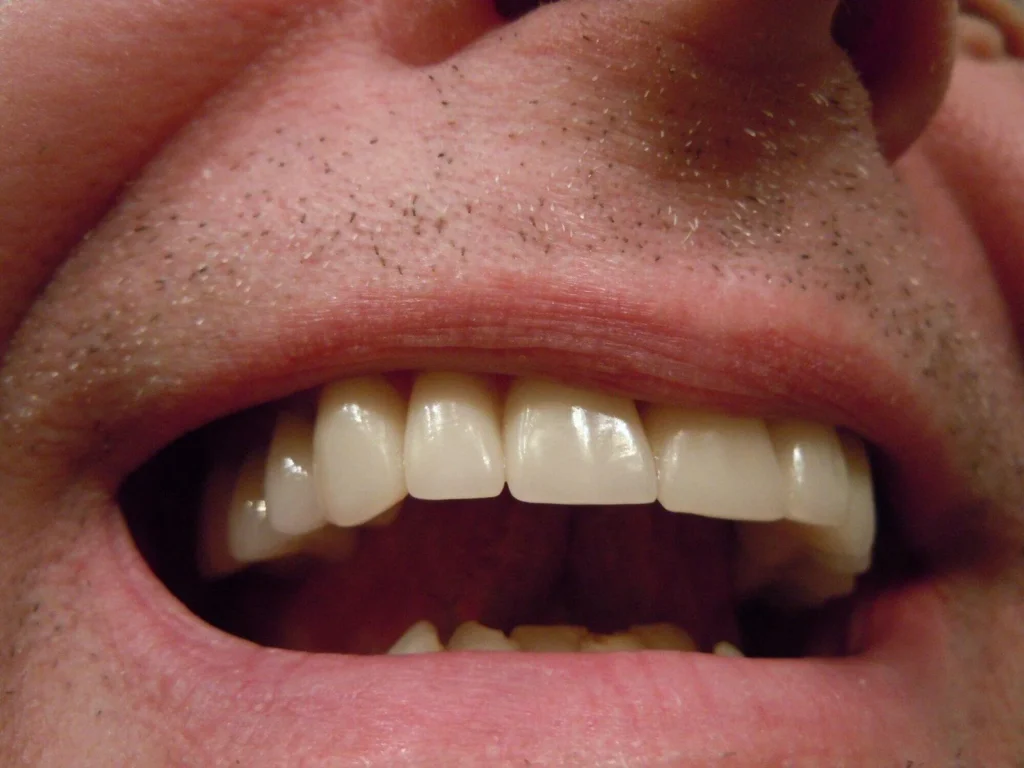Dental crowns are a powerful tool in cosmetic dentistry, providing remarkable improvements in dental aesthetics. They play a crucial role in various dental procedures aimed at smile transformation.
In this article, we will explore the journey of dental crowns before and after, focusing on their transformative effects before and after the procedure. We will discuss the importance of dental restoration practices, the process of tooth restoration, and the impact of cosmetic dental treatments on a patient’s confidence and smile.
What are Dental Crowns?
Dental crowns are personalized caps designed to cover and protect a tooth that is damaged or decayed. They restore the tooth’s shape, size, and strength and improve its appearance. Crowns are often used if a big filling can’t replace enough tooth structure, there’s a lot of decay, or after a root canal to protect the weakened tooth.
They can be made from various materials such as:
- porcelain
- metal
- plastic
Why Consider Dental Crowns?
Dental crowns serve multiple purposes in dental restoration. They can cover and support a tooth with a large filling when not enough tooth is left. They hold dental bridges in place and can cover misshapen or severely discolored teeth.
In essence, crowns play a pivotal role in a dental makeover. It aids in both functional and cosmetic improvements.
The Dental Crown Procedure
The dental crown procedure typically involves two visits to the dentist. During the first visit, the tooth is prepared. The dentist may perform the following:
- X-rays
- remove decayed or damaged parts
- shape the tooth to fit the crown
- create impressions
A temporary crown, often made from acrylic or stainless steel, is placed to protect the tooth until the permanent crown is ready.
On the second visit, the temporary crown is removed, and the new crown is checked for fit and color. If everything is satisfactory, the permanent crown is cemented into place. This two-step procedure ensures precision and effectiveness in tooth restoration.
Benefits of Dental Crowns
There are benefits to getting dental crowns, including the following.
Enhanced Aesthetics
One of the primary reasons patients opt for dental crowns is the improvement in dental aesthetics. A well-crafted crown can look indistinguishable from natural teeth. This provides a seamless smile transformation.
This aesthetic enhancement results in increased confidence and a more appealing appearance.
Durability and Strength
Dental crowns provide significant durability and strength to weakened teeth. They are designed to withstand the forces of biting and chewing. This extends the life of a tooth that might otherwise require extraction.
This contributes to overall dental health and maintains the structure of the mouth.
Protection and Preservation
Crowns offer crucial protection for damaged or decayed teeth. By covering and encapsulating a compromised tooth, crowns prevent further deterioration. This reduces the risk of infection or additional dental issues.
This shield keeps the tooth strong and functional, crucial for a healthy smile.
Dental Crowns Before and After
The change from dental crowns before to after can be a big one. After the procedure, patients often mention the big changes in how things look and work. Let’s delve into specific examples to illustrate this change.
Case Study: Cosmetic Improvement
Consider a patient with severely stained and chipped front teeth. These teeth might affect their willingness to smile openly and impact their self-esteem. After undergoing a dental crown procedure, the same patient sees a remarkable change.
The new crowns match the color and shape of their natural teeth, resulting in a bright, confident smile. This case exemplifies how cosmetic dental treatments like crowns can drastically enhance dental aesthetics.
Case Study: Structural Integrity
Another example involves a patient with a cracked molar compromising their ability to chew properly. A dental crown can restore the tooth, providing strength and durability.
The patient experiences relief from discomfort and regains full functionality of their bite. This improvement in structural integrity underscores the importance of dental procedures that focus on strengthening teeth.
Types of Dental Crowns
There are types of dental crowns that cater to different needs and preferences. Each type has its unique advantages, making it suitable for certain situations.
Porcelain Crowns
Porcelain crowns are popular due to their natural appearance. They are ideal for visible front teeth since they blend seamlessly with other teeth. Porcelain crowns resist staining and provide a long-lasting aesthetic solution.
Metal Crowns
Metal crowns are made from gold or platinum alloys. These are known for their strength and endurance. They are less likely to chip or break and require minimal tooth removal.
However, their metallic color makes them less suitable for visible areas and more ideal for back teeth.
Porcelain-Fused-to-Metal (PFM) Crowns
PFM crowns combine the durability of metal with the aesthetic appeal of porcelain. They offer a balance between strength and appearance. This makes them a versatile option for a variety of dental restoration needs.
Full Ceramic or Porcelain Crowns
Full ceramic or porcelain crowns provide a metal-free option and can offer a highly natural look. They are especially recommended for patients with metal allergies.
Caring for Dental Crowns
Maintaining dental hygiene is crucial for the longevity of dental crowns. Regular brushing, flossing, and dental check-ups help ensure the crown stays in good condition.
Avoiding hard foods and sticky candies and addressing habits like teeth grinding can also prolong their life.
The Role of Crowns in a Dental Makeover
Dental makeovers often include multiple procedures aimed at enhancing a patient’s smile. Dental crowns play a significant role in these transformations. They fix decayed, damaged, or bad teeth so patients can get the look and function they want.
Beyond the physical changes, the psychological benefits of smile transformation are profound. Improving one’s smile through dental procedures can lead to the following:
- increased self-confidence
- higher self-esteem
- greater social engagement
Witness the Transformative Power of Dental Crowns Before and After
Dental crowns offer a remarkable solution for those seeking both functional and cosmetic improvements in their dental health. From enhancing aesthetics to providing structural support, the benefits of dental crowns before and after the procedure are extensive.
By understanding the dental crown procedure and its impact on smile transformation, patients can make informed decisions about their dental care. A transformative smile is within reach, thanks to the advancements in cosmetic dentistry and the effectiveness of dental crowns in dental restoration.
For more on this content, visit the rest of
Transformative Smiles: Dental Crowns Before and After
sdf
Witness transformative smiles with dental crowns before and after comparisons. Explore the remarkable results and rejuvenated smiles with our gallery.
Keyword(s): dental crowns before and after
Anchor Text: dental crown procedure
Dental crowns are a powerful tool in cosmetic dentistry, providing remarkable improvements in dental aesthetics. They play a crucial role in various dental procedures aimed at smile transformation.
In this article, we will explore the journey of dental crowns before and after, focusing on their transformative effects before and after the procedure. We will discuss the importance of dental restoration practices, the process of tooth restoration, and the impact of cosmetic dental treatments on a patient’s confidence and smile.
What are Dental Crowns?
Dental crowns are personalized caps designed to cover and protect a tooth that is damaged or decayed. They restore the tooth’s shape, size, and strength and improve its appearance. Crowns are often used if a big filling can’t replace enough tooth structure, there’s a lot of decay, or after a root canal to protect the weakened tooth.
They can be made from various materials such as:
- porcelain
- metal
- plastic
Why Consider Dental Crowns?
Dental crowns serve multiple purposes in dental restoration. They can cover and support a tooth with a large filling when not enough tooth is left. They hold dental bridges in place and can cover misshapen or severely discolored teeth.
In essence, crowns play a pivotal role in a dental makeover. It aids in both functional and cosmetic improvements.
The Dental Crown Procedure
The dental crown procedure typically involves two visits to the dentist. During the first visit, the tooth is prepared. The dentist may perform the following:
- X-rays
- remove decayed or damaged parts
- shape the tooth to fit the crown
- create impressions
A temporary crown, often made from acrylic or stainless steel, is placed to protect the tooth until the permanent crown is ready.
On the second visit, the temporary crown is removed, and the new crown is checked for fit and color. If everything is satisfactory, the permanent crown is cemented into place. This two-step procedure ensures precision and effectiveness in tooth restoration.
Benefits of Dental Crowns
There are benefits to getting dental crowns, including the following.
Enhanced Aesthetics
One of the primary reasons patients opt for dental crowns is the improvement in dental aesthetics. A well-crafted crown can look indistinguishable from natural teeth. This provides a seamless smile transformation.
This aesthetic enhancement results in increased confidence and a more appealing appearance.
Durability and Strength
Dental crowns provide significant durability and strength to weakened teeth. They are designed to withstand the forces of biting and chewing. This extends the life of a tooth that might otherwise require extraction.
This contributes to overall dental health and maintains the structure of the mouth.
Protection and Preservation
Crowns offer crucial protection for damaged or decayed teeth. By covering and encapsulating a compromised tooth, crowns prevent further deterioration. This reduces the risk of infection or additional dental issues.
This shield keeps the tooth strong and functional, crucial for a healthy smile.
Dental Crowns Before and After
The change from dental crowns before to after can be a big one. After the procedure, patients often mention the big changes in how things look and work. Let’s delve into specific examples to illustrate this change.
Case Study: Cosmetic Improvement
Consider a patient with severely stained and chipped front teeth. These teeth might affect their willingness to smile openly and impact their self-esteem. After undergoing a dental crown procedure, the same patient sees a remarkable change.
The new crowns match the color and shape of their natural teeth, resulting in a bright, confident smile. This case exemplifies how cosmetic dental treatments like crowns can drastically enhance dental aesthetics.
Case Study: Structural Integrity
Another example involves a patient with a cracked molar compromising their ability to chew properly. A dental crown can restore the tooth, providing strength and durability.
The patient experiences relief from discomfort and regains full functionality of their bite. This improvement in structural integrity underscores the importance of dental procedures that focus on strengthening teeth.
Types of Dental Crowns
There are types of dental crowns that cater to different needs and preferences. Each type has its unique advantages, making it suitable for certain situations.
Porcelain Crowns
Porcelain crowns are popular due to their natural appearance. They are ideal for visible front teeth since they blend seamlessly with other teeth. Porcelain crowns resist staining and provide a long-lasting aesthetic solution.
Metal Crowns
Metal crowns are made from gold or platinum alloys. These are known for their strength and endurance. They are less likely to chip or break and require minimal tooth removal.
However, their metallic color makes them less suitable for visible areas and more ideal for back teeth.
Porcelain-Fused-to-Metal (PFM) Crowns
PFM crowns combine the durability of metal with the aesthetic appeal of porcelain. They offer a balance between strength and appearance. This makes them a versatile option for a variety of dental restoration needs.
Full Ceramic or Porcelain Crowns
Full ceramic or porcelain crowns provide a metal-free option and can offer a highly natural look. They are especially recommended for patients with metal allergies.
Caring for Dental Crowns
Maintaining dental hygiene is crucial for the longevity of dental crowns. Regular brushing, flossing, and dental check-ups help ensure the crown stays in good condition.
Avoiding hard foods and sticky candies and addressing habits like teeth grinding can also prolong their life.
The Role of Crowns in a Dental Makeover
Dental makeovers often include multiple procedures aimed at enhancing a patient’s smile. Dental crowns play a significant role in these transformations. They fix decayed, damaged, or bad teeth so patients can get the look and function they want.
Beyond the physical changes, the psychological benefits of smile transformation are profound. Improving one’s smile through dental procedures can lead to the following:
- increased self-confidence
- higher self-esteem
- greater social engagement
Witness the Transformative Power of Dental Crowns Before and After
Dental crowns offer a remarkable solution for those seeking both functional and cosmetic improvements in their dental health. From enhancing aesthetics to providing structural support, the benefits of dental crowns before and after the procedure are extensive.
By understanding the dental crown procedure and its impact on smile transformation, patients can make informed decisions about their dental care. A transformative smile is within reach, thanks to the advancements in cosmetic dentistry and the effectiveness of dental crowns in dental restoration.
For more on this content, visit the rest of our blog!







